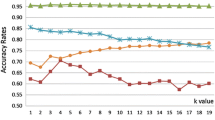Abstract
The nearest neighbors (NNs) classifiers, especially the k-Nearest Neighbors (kNNs) algorithm, are among the simplest and yet most efficient classification rules and widely used in practice. It is a nonparametric method of pattern recognition. In this paper, k-Nearest Neighbors, one of the most commonly used machine learning methods, work in automatic classification of multi-wavelength astronomical objects. Through the experiment, we conclude that the running speed of the kNN classier is rather fast and the classification accuracy is up to 97.73%. As a result, it is efficient and applicable to discriminate active objects from stars and normal galaxies with this method. The classifiers trained by the kNN method can be used to solve the automated classification problem faced by astronomy and the virtual observatory (VO).
Similar content being viewed by others
References
Rumelhart D E, Hinton G E, Williams R J. Learning internal representations by error propagation. Nature, 1986, 323(09): 533–536
Gulati R K, Gupta R, Gothoskar P, et al. Ultraviolet stellar spectral classification using multilevel tree neural network. Vistas Astron, 1994, 38(3): 293–298
Bailer-Jones C A L. Neural network classification of stellar spectra. Publ Astron Soc Pac, 1997, 109: 932
Sodre L, Cuevas H. Spectral classification of galaxies. Vistas Astron, 1994, 38: 287–291
Storrie-Lombardi M C, Lahav O, Sodre L J, et al. Morphological classification of galaxies by articial neural networks. Mon Not R Astron Soc, 1992, 259: 8–12
Adams A, Woolley A. Hubble classification of galaxies using neural networks. Vistas Astron, 1994, 38: 273–280
Odewahn S C, Nielsen M L. Star-galaxy separation using neural networks. Vistas Astron, 1994, 38: 281–285
McGlynn T A, Suchkov A A, Winter E L, et al. Automated classification of ROSAT sources using heterogeneous multiwavelength source catalogs. Astrophys J, 2004, 616:1284–1300
Zhang Y, Zhao Y. Classification in multidimensional parameter space: Methods and examples. Publ Astron Soc Pac, 2003, 115: 1006–1018
Qu M, Shih F Y, Jing J, et al. Automatic solar flare detection using MLP, RBF, and SVM. Sol Phys, 2003, 217: 157–172
Quinlan J. Induction of decision trees. Mach Learn, 1986, 1: 81–106
Humphreys R M, Karypis G, Hasan M, et al. Experiments in automating the morphological classification of galaxies. Am Astron Soc, 2001, 33: 1322
Ramirez J F, Fuentes O, Gulati R K. Prediction of stellar atmospheric parameters using instance-based machine learning and genetic algorithms. Exp Astron, 2001, 12(3): 163–178
Fix E, Hodges J L. Discriminatory analysis-nonparametric discrimination: Consistency properties. Int Sta Rev/Revue Internationale de Statistique, 1989, 57(3): 238–247
Duda R O, Hart P E. Pattern Recognition and Scene Analysis. New York: Wiley, 1973
Devroye L, Gyori L, Lugosi G. A Probabilistic Theory of Pattern Recognition. New York: Springer-Verlag, 1996
Dasarathy B V. Nearest neighbor norms-NN pattern classification techniques. Los Alamitos: IEEE Comp, Society Press, 1991
Zhang Y, Zhao Y. Automated clustering algorithms for classification of astronomical objects. Astron Astrophys, 2004, 422: 1113–1121
Veron-Cetty M P, Veron P. A catalogue of quasars and active nuclei. ESO Scientic Report 19, 2000
de Vaucouleurs G, de Vaucouleurs A, Corwin H G, et al. Third Reference Catalogue of Bright Galaxies (RC3). New York: Springer-Verlag, 1991
Author information
Authors and Affiliations
Corresponding author
Additional information
Supported by the National Natural Science Foundation of China (Grant Nos. 10473013, 10778724 and 90412016)
Rights and permissions
About this article
Cite this article
Li, L., Zhang, Y. & Zhao, Y. k-Nearest Neighbors for automated classification of celestial objects. Sci. China Ser. G-Phys. Mech. Astron. 51, 916–922 (2008). https://doi.org/10.1007/s11433-008-0088-4
Received:
Accepted:
Published:
Issue Date:
DOI: https://doi.org/10.1007/s11433-008-0088-4




